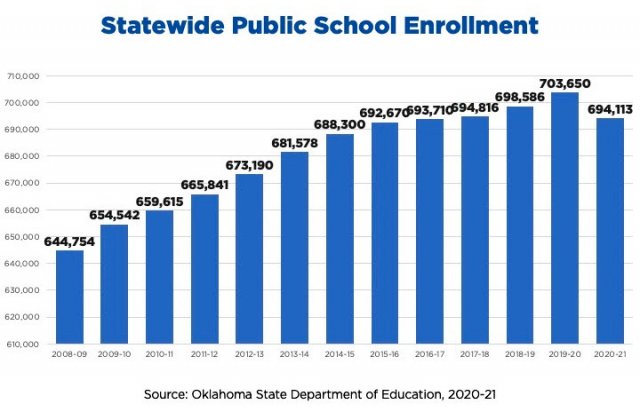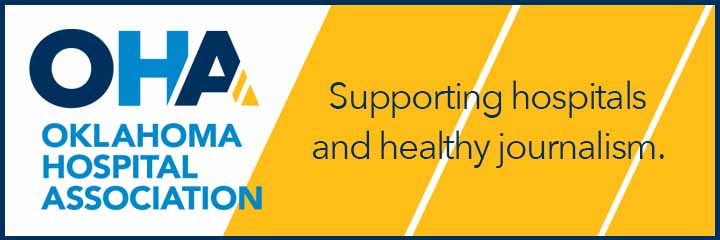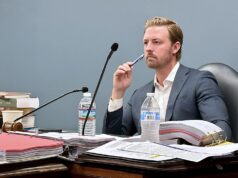

Total Oklahoma public school enrollment fell by 9,537 students — or about 1.5 percent — for the current school year, marking the first time statewide enrollment has dropped in more than a decade.
But a deeper look at the statistics released this afternoon by the Oklahoma State Department of Education shows that traditional public school districts saw an even bigger enrollment contraction as students flocked to virtual learning programs such as Epic Charter Schools. Both Epic One-on-One (17,106 to 35,731) and Epic Blended Learning (10,962 to 23,714) saw more than a 110 percent enrollment increase. Other virtual charter schools saw leaps as well.
State Superintendent of Public Instruction Joy Hofmeister said the decline — and the migration of tens of thousands of students to Epic virtual charter schools — stems from the COVID-19 pandemic.
“This pandemic has presented a multitude of challenges, and lower early childhood enrollment numbers tell us we will need to heighten our focus on early learning opportunities and strategic interventions to ensure these children have the prerequisite skills needed for reading and math,” Hofmeister said in a press release. “Copious evidence points to the effectiveness of early childhood education in preparing children for lives of learning and academic success, and we are deeply committed to serving our youngest learners.”
Money follows students
For traditional public schools, the numbers released Thursday are troubling, as state funding is tied to enrollment data under Oklahoma law.
Secretary of Education Ryan Walters pointed to the Oklahoma public school enrollment statistics as further reason for districts to heed Gov. Kevin Stitt’s request that they find ways to open for in-person instruction this spring.
“These numbers reflect what we’ve been hearing from parents for months: Virtual learning is not effective for young students,” Walters said in a statement to NonDoc. “It is imperative that every school in Oklahoma reopen so parents have in-person learning as an option for their student.”
House Appropriations and Budget Education Subcommittee Chairman Mark McBride (R-Moore) said the numbers are concerning but not unexpected.
“We knew Epic enrollment was going to be up,” McBride said. “I think it may take some time, but I think it will all level out once the pandemic is over.”
McBride and other legislators have already heard from school districts about how declining enrollment will affect state funding.
“I think that’s one thing we are going to need to look at for the upcoming [session] is just look at how this might affect some of these school districts,” McBride said. “This may be a time when everybody has to tighten their belt going forward because the system is somewhat designed for the money to follow the student.”
The state education funding formula is also designed to equalize district funding after consideration of local property tax dollars and other revenue sources.
Rep. Logan Phillips (R-Mounds) has been hearing about the issue from school superintendents around eastern Oklahoma for months.
“I think we have an incredibly looming threat to public education right now,” he said, noting that lower enrollment leads to fewer state dollars for traditional public schools. “That’s less income going into public education and fewer wrap-around services. “It could create a system where some of our public schools won’t have enough income to operate under what is mandated of them at the state and the federal level.”
He said the school districts he represents are having a difficult time competing with virtual charter schools.
“My districts are struggling. They’re trying to come up with anything that can act as digital learning or distance learning programs,” Phillips said. “I’m not sure what that looks like, though. They’re building their programs now, but they are 10 years behind the virtual schools.”
He said he also fears the pandemic’s impact on teachers, who were not trained to conduct school virtually.
“I’m afraid you’re going to see a bunch of teachers leave the profession as well because this is not the lifestyle they signed up for,” Phillips said. “I hope there’s a light at the end of the tunnel and I hope I’m wrong.”
Rep. Ronny Johns (R-Ada) spent 32 years as a teacher and eventually principal in Ada Public Schools. He said Thursday that he had heard from superintendents and parents who said some students switched to virtual charter schools because those schools have more experience in distance learning.
“In my district, I get the feeling that our schools are doing a good job with virtual learning and have good programs available for our students,” he said. “So that’s a positive.”
Johns also said the shifts in public school enrollment pose potential financial issues for districts.
“I think there’s some uncertainty there,” Johns said. “We’ll see how that plays out. But yes, I think there is concern there obviously.”
He said the situation could be the focus of legislative action when the 2021 session starts in February.
“I know other states have their virtual charter schools on a different funding formula than their (traditional) public schools,” Johns said. “So I think that’s something the state of Oklahoma maybe ought to look at.”
District-by-district enrollment data
Some of the state’s largest school districts saw significant declines in enrollment, including:
- Oklahoma City Public Schools saw a 12.2 percent decrease (42,513 to 37,344)
- Tulsa Public Schools saw a 7.1 percent decrease (38,509 to 35,765)
- Mid-Del Public Schools saw a 22.3 percent decrease (14,207 to 11,044)
- Western Heights saw a 20.18 percent decrease (3,419 to 2,729)
- Edmond Public Schools saw a 8.29 percent decrease (25,619 to 23,496)
- Moore Public Schools saw a 6.29 percent decrease (24,961 to 23,390)
Complete data about Oklahoma public school enrollment can be found here. A spreadsheet comparing district enrollment between the 2019-2020 school year and the current 2020-2021 school year is embedded below.
‘The vaccine can’t come soon enough’
In a statement to NonDoc, Oklahoma Education Association President Alicia Priest emphasized the importance of communities following social distancing guidelines and wearing masks to mitigate the virus spread so that schools can meet face-to-face.
“We understand and share the concerns of parents and the difficulty of our youngest students having to work virtually,” Priest said. “This drop in enrollment is just another reason we need school to be as safe as possible for in-person teaching and learning. The vaccine can’t come soon enough for our educators and the families we serve.”
(Update: This article was updated at 3:23 p.m. Thursday, Jan. 7, to include quotes from McBride. It was updated again at 3:45 p.m. to include quotes from Phillips and at 4:53 p.m. to include quotes from Johns. It was updated a final time at 6 p.m. to include a statement from Priest.)




















